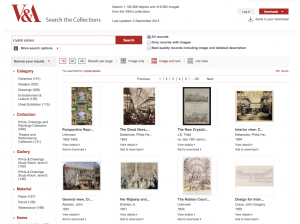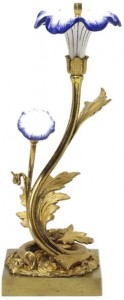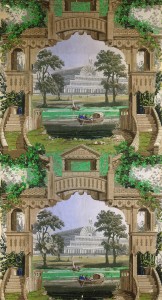The Great Exhibition of 1851, Hyde Park, London

The Victoria & Albert Musuem’s Resources on the Great Exhibition of 1851
The Crystal Palace: The Victoria & Albert Museum
Correct Principles of Taste & The Chamber of Horrors
Charles Eastlake, Hints on Household Taste (1868)
“The perfect finish and accurate uniformity of shape,–the correct and even balance of pattern-form which distinguish European goods from those of Eastern nations, and English goods especially from those of other countries in Europe,–indicate degrees not only of advanced civilization, but, inversely, of decline in taste.” (105)
“In fact, the very irregularity of form and inequality of tint which distinguish these objects of ancient art, conduced towards their real beauty; for they were the evidence of human handiwork, and that to the end of time will always be more interesting than the result of mechanical precision.” (105-06)
“In this, as in every branch of art-manufacture, it is for the shops to lead the way towards reform. The British public are, as a body, utterly incapable of distinguishing good from bad design, and have not time to inquire into principles. As long as gaudy and extravagant trash is displayed in the windows of our West End thoroughfares, so long will it attract ninety-nine people out of every hundred to buy. But let customers once become familiar with the sight of good forms and judicious combinations of color, and we may one day aspire to the formation of a national taste.” (118-19)

Literary Responses
Wilkie Collins’s Basil (1852)
The brilliant-varnished door cracked with a report like a pistol when it was opened; the paper on the walls, with its gaudy pattern of birds, trellis-work, and flowers in gold, red and green on a white ground, looked hardly dry yet; the showy window-curtains of white and sky-blue, and the still showier carpet of red and yellow, seemed as if they had come out of the shop yesterday …’ The violent colours and restless patterns affront his self-consciously cultivated taste, and he feels that ‘the room would have given a nervous man the headache before he had been in it a quarter of an hour’.
Charles Dickens’s Hard Times (1854)
“Let me ask you girls and boys, would you paper a room with representations of horses? … Of course not … Do you ever see horses walking up and down the sides of a room in reality – in fact? … Of course not. Why, then, you are not to have, in any object of use or ornament what would be a contradiction in fact … You must use for all purposes, combinations and modifications (in primary colours) of mathematical figures which are susceptible of proof and demonstration. This is the new discovery. This is fact. This is taste.'”
Henry Morley, “A House Full of Horrors” (1852)

“I could have cried, sir. I was ashamed of the pattern of my own trowsers, for I saw a piece of them hung up there as a horror. I dared not pull out my pocket-handkerchief while any one was by, lest I should be seen dabbing the perspiration from my forehead with a wreath of coral. I saw it all; when I went home I found that I had been living among horrors up to that hour. The paper in my parlour contains four kinds of birds of paradise, besides bridges and pagodas” (61).
“As old horrors wear out, I shall replace them according to correct principles of Taste. Whenever anything new is to be bought, since it will cost no more to have a thing in right taste than in wrong, I mean to be particular about the choosing of it.” (61)
“I am a haunted man, molested in my peace by horrid sights, which follow one another almost without intermission. A person with my present correct principles of taste is naturally shocked every hour of his life in London.” (61-62)
“Mr Frippy, sir,” I replied, “one correct principle of taste in dress is, that the pattern of a dress should harmonise with the form and motions of the body upon which it is worn. Stripe your trousers vertically if they must be striped, so that the lines may harmonise in direction with the movement of your figure. The bars across your legs and body suggest obstacle and opposition. They are ungraceful also in being large and violently visible. Against a small check in which there is no strong contrast of colours, and which has no strongly pronounced lines in any direction, the authority on which I stand wages no war. There are four trouser patterns hung up in the Chamber of Horrors at Marlborough House, not one of which is so detestable as that which you are wearing.” (63)
Morley, Quoting from the Great Exhibition Catalogue
“The art of ornamenting consists in the application of natural modes of decoration, not in applying pictures or sculptures of natural objects to our fabrics. If you ask me why Oriental ornamentation is so agreeable and natural, though it consists of little that resembles natural objects, I reply at once, it is because Oriental fabrics are ornamented in the same way as natural objects are. The forms employed are natural and beautiful forms; the colours are arranged, and contrasted, and modified as we find them in nature. The lines are such as we find in almost every other flower or object that meets us, and therefore always pleasing. The object of the ornamentist is not to make mere copies of natural objects, and to paint pictures, or carve images of them on the furniture and appliances of life. His purpose is to adorn the contrivances of mechanical and architectural skill, by the application of those principles of decoration, and of those forms and modes of beauty, which Nature herself has employed in adorning the structure of the world.” (64-65)
Further Reading
Cohen, Deborah. Household Gods: The British and Their Possessions. Yale UP, 2006.
Collins, Wilkie. Basil. 1852.
Dickens, Charles, Hard Times. 1854.
Eastlake, Charles. Hints on Household Taste. 1868.
Gaskell, Peter. “Domestic Manufactures.” Artisans and Machinery. 1836.
Ruskin, John. “The Lamp of Truth,” The Seven Lamps of Architecture (1849)